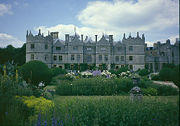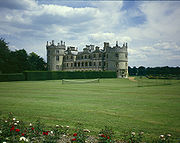
Longford Castle
Encyclopedia



Salisbury
Salisbury is a cathedral city in Wiltshire, England and the only city in the county. It is the second largest settlement in the county...
, Wiltshire
Wiltshire
Wiltshire is a ceremonial county in South West England. It is landlocked and borders the counties of Dorset, Somerset, Hampshire, Gloucestershire, Oxfordshire and Berkshire. It contains the unitary authority of Swindon and covers...
, England
England
England is a country that is part of the United Kingdom. It shares land borders with Scotland to the north and Wales to the west; the Irish Sea is to the north west, the Celtic Sea to the south west, with the North Sea to the east and the English Channel to the south separating it from continental...
.
In 1573 Thomas Gorges
Thomas Gorges
Thomas Gorges , an Elizabethan courtier and Groom of the Chamber to Queen Elizabeth I, a second cousin of Queen Anne Boleyn, the mother of Queen Elizabeth I all descendants of the first Howard Duke of Norfolk.His father was Sir Edward Gorges of Wraxall,and his mother one of Sir Edward's...
, of Langford acquired the manor (at the time written "Langford"), which was originally owned by the Cervingtons. Prior to this the existing mansion house had been damaged by fire. In c 1576 Thomas Gorges married Helena Snakenborg, the Swedish born dowager Marchioness of Northampton and Lady-in-waiting to Queen Elizabeth
Elizabeth I of England
Elizabeth I was queen regnant of England and Ireland from 17 November 1558 until her death. Sometimes called The Virgin Queen, Gloriana, or Good Queen Bess, Elizabeth was the fifth and last monarch of the Tudor dynasty...
. They rebuilt the Longford property as a triangular Swedish pattern castle on the banks of the River Avon. Unfortunately, the building work became very expensive due to problems with the subsoil. Sir Thomas Gorges, who was now governor of Hurst Castle
Hurst Castle
Hurst Castle on the south coast of England is one of Henry VIII's Device Forts, built at the end of a long shingle barrier beach at the west end of the Solent to guard the approaches to Southampton. Hurst Castle was sited at the narrow entrance to the Solent where the ebb and flow of the tides...
, persuaded his wife to beg of the Queen a shipwreck he knew from the defeated Spanish Armada
Spanish Armada
This article refers to the Battle of Gravelines, for the modern navy of Spain, see Spanish NavyThe Spanish Armada was the Spanish fleet that sailed against England under the command of the Duke of Medina Sidonia in 1588, with the intention of overthrowing Elizabeth I of England to stop English...
. The gift was granted and the gold and silver retrieved from the shipwreck funded the completion of the castle under the final supervision of John Thorpe
John Thorpe
John Thorpe or Thorp was an English architect. Little is known of his life, and his work is dubiously inferred, rather than accurately known, from a folio of drawings in the Sir John Soane's Museum, to which Horace Walpole called attention, in 1780, in his Anecdotes of Painting; but how far these...
in 1591. The family lived in the castle for several years before its final completion.
The main building had several floors and was triangular with a round tower in each corner; the three towers representing the Father, the Son and the Holy Ghost. There was a chapel, kitchen department, several boudoirs and sitting rooms, as well as bedrooms. Fresh cold water was pumped to various floors and there were water closets operating with rainwater. A park, fruit garden and kitchen garden were attached.
In 1717 Longford Castle became the Bouverie home, purchased by Sir Edward Des Bouverie from the Coleraines. It is said that Sir Edward saw and fell in love with the castle in the valley as he rode past, having enough money in his saddle bags to effect the purchase there and then. Subsequent generations of the family beautified the interior of the castle and surrounding park. However, Jacob, 2nd Earl of Radnor (1749-1828), employed James Wyatt
James Wyatt
James Wyatt RA , was an English architect, a rival of Robert Adam in the neoclassical style, who far outdid Adam in his work in the neo-Gothic style.-Early classical career:...
to change Longford from a reasonably modest chateau into a hexagonal palace "to the despair of future generations" . He destroyed one of the Elizabethan towers and replaced it with a larger one of his own design, added two more towers and linked each to each other. The palace concept was not finished. It was Jacob, 4th Earl of Radnor (1815-1889), who oversaw the last significant changes to the castle architecture, undertaken by Anthony Salvin
Anthony Salvin
Anthony Salvin was an English architect. He gained a reputation as an expert on medieval buildings and applied this expertise to his new buildings and his restorations...
. These included the formation of a second courtyard, the doming over of the central courtyard and the addition of a square tower that can be seen in the aerial photograph.
Longford Castle is currently the seat of William Pleydell-Bouverie
William Pleydell-Bouverie, 9th Earl of Radnor
William Pleydell-Bouverie, 9th Earl of Radnor , of Longford Castle, Wiltshire, is an English peer and landowner.The son of Jacob Pleydell-Bouverie, 8th Earl of Radnor and Anne Garden Seth-Smith, daughter of Donald Farquharson Seth-Smith, Pleydell-Bouverie was educated at Harrow and the Royal...
, 9th Earl of Radnor
Earl of Radnor
Earl of Radnor is a title which has been created two times. It was first created in the Peerage of England in 1679 for John Robartes, 2nd Baron Robartes, a notable political figure of the reign of Charles II. He was made Viscount Bodmin at the same time. Robartes was the son of Richard Robartes,...
, and is not open to the public.
Other notable uses
- Longford was the model for the 'Castle of Amphialeus' in Sir Philip SidneyPhilip SidneySir Philip Sidney was an English poet, courtier and soldier, and is remembered as one of the most prominent figures of the Elizabethan Age...
's The Countess of Pembroke's ArcadiaCountess of Pembroke's ArcadiaThe Countess of Pembroke's Arcadia, also known simply as the Arcadia or the Old Arcadia, is a long prose work by Sir Philip Sidney written towards the end of the sixteenth century, and later published in several versions. It is Sidney's most ambitious literary work, by far, and as significant in...
(1580, pub. 1590). - In the 1914-18 war the castle was a hospital.
- In the 1939-45 war the castle was occupied by British and American troops and entertained Montgomery, Mark Clark and Creagh.
- Longford Castle is shown from the air at the end of the movie The Princess Diaries as the castle in Genovia.

